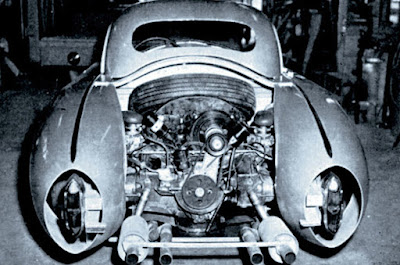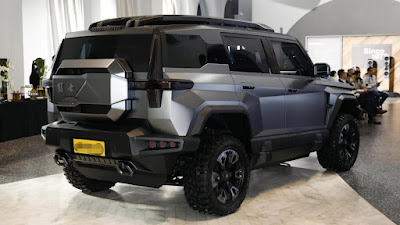Genesis EV - The Korean luxury brand Genesis unveiled its latest masterpieces at the Genesis House New York, setting the stage for a new era in automotive innovation. On March 25, 2024, enthusiasts and industry insiders were treated to a glimpse of the future with the Genesis Neolun Concept and the Genesis GV60 Magma Concept.
 |
| A lineup of Genesis Magma series models sat on display at the prestigious New York International Auto Show. (Picture from: RPMNewsWeekly) |
1. Genesis Neolun Concept
The Genesis Neolun Concept represents a leap forward in electric SUV technology, embodying a fusion of cutting-edge features and design excellence. Inspired by Korea's iconic moon-shaped porcelain jars, the Neolun concept symbolizes Genesis' commitment to timeless aesthetics and meticulous craftsmanship.
 |
| The Genesis Neolun Concept represents a leap forward in electric SUV technology, embodying a fusion of cutting-edge features and design excellence. (Picture from: CarAndDriver) |
Chief Creative Officer Luc Donckerwolke remarked that the design language of the Neolun Concept transcends the ordinary, blending newness with the allure of the moon.
 |
| A notable feature of the Neolun Concept is its innovative carriage door design, seamlessly integrated without the conventional B pillar. (Picture from: CarAndDriver) |
One of the standout features of the Neolun Concept is its innovative carriage door design, seamlessly integrated without the traditional B pillar. This not only enhances the vehicle's aesthetics but also improves interior spaciousness and accessibility for passengers.
 |
| The Genesis Neolun Concept enhances both the vehicle's aesthetics and interior spaciousness, providing improved accessibility for passengers. (Picture from: CarAndDriver) |
Genesis has achieved a remarkable milestone in engineering by bringing this concept to life, signaling a bold direction for future production vehicles.
 |
| The Genesis Neolun Concept draws inspiration from Korea's iconic moon-shaped porcelain jars, embodying Genesis' dedication to timeless aesthetics and meticulous craftsmanship. (Picture from: CarAndDriver) |
Genesis emphasizes that they "don't create show cars for the sake of show business," signaling that a production version of the Neolun concept is in the works. This flagship SUV is slated for release in the near future, with an anticipated arrival within the next five years.
2. Genesis GV60 Magma Concept
On the performance front, the Genesis GV60 Magma Concept steals the spotlight with its captivating blend of aggression and elegance. The muscular wheel arches, aerodynamic enhancements, and striking color palette define the GV60 Magma as a symbol of power and sophistication. Inside, luxury meets functionality with premium materials and attention to detail, promising an unparalleled driving experience.
 |
| The Genesis GV60 Magma Concept embodies power and sophistication, featuring muscular wheel arches, aerodynamic enhancements, and a striking color palette. (Picture from: CarAndDriver) |
Genesis doesn't just stop at showcasing these concepts; it teases a broader Magma program that promises high-performance variants across its lineup. From the GV80 Coupe concept to the G80 Magma Special and the X Gran Berlinetta concept, Genesis is redefining automotive excellence with a focus on innovation and driving pleasure.
 |
| When it comes to performance, the Genesis GV60 Magma Concept shines with its captivating blend of aggression and elegance. (Picture from: Demokratis.co.id) |
A key aspect of Genesis' vision is its collaboration with racing legend Jacky Ickx, hinting at the brand's commitment to delivering exhilarating performance on the road. This partnership underscores Genesis' dedication to pushing boundaries and creating vehicles that thrill enthusiasts worldwide.
 The grand reveal of the Neolun Concept, GV60 Magma Concept, and other Genesis models took place at the prestigious New York International Auto Show, showcasing Genesis' prowess in blending luxury, technology, and performance. As the automotive landscape evolves, Genesis stands at the forefront, shaping the future of mobility with its bold designs and unwavering dedication to excellence. *** [EKA | FROM VARIOUS SOURCES | GENESIS | AUDACY | CARANDDRIVER | RPMNEWSWEEKLY ]
The grand reveal of the Neolun Concept, GV60 Magma Concept, and other Genesis models took place at the prestigious New York International Auto Show, showcasing Genesis' prowess in blending luxury, technology, and performance. As the automotive landscape evolves, Genesis stands at the forefront, shaping the future of mobility with its bold designs and unwavering dedication to excellence. *** [EKA | FROM VARIOUS SOURCES | GENESIS | AUDACY | CARANDDRIVER | RPMNEWSWEEKLY ]Note: This blog can be accessed via your smart phone.







































